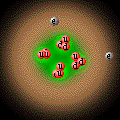 PHYS 301 MODERN
PHYSICS FALL 2013
PHYS 301 MODERN
PHYSICS FALL 2013
Text Book: Concepts of Modern Physics by Arthur Beiser 5th Ed.( McGraw-Hill 1995) ISBN 0-07-004814-2
A supplementary recommended website that has web-based interactive exercises with live simulations (physlets)
Modern Physics Notes from UVA that supplement this course.
Professor: Dr.
Mesgun Sebhatu, 203 Sims Bldg.
Office hrs: 10-10:50 MWF or by appointment.
This is being offered as an independent
study course. Class meets one hour a week in Sims 203 and/or 205 to answer
questions and help solve assigned weekly problems. Students who take
intermediate level physics courses as independent study, are highly motivated and are
expected to study and work hard on thier own with some guidance formthe
instructor. My role will be more of a tutor
and not a lecturer.
The approach I use for independent study courses is to be a guide on the side rather than a sage on the stage.
Tel: 803-323 - 4935(Office) E-mail: sebhatum@winthrop.edu
Modern physics refers to physics developed in the 20th century. It includes, the special and general theory of relativity, quantum theory, as well as nuclear and particle physics. These topics are challenging both conceptually and mathematically. They are, however, the basis for all the technological wonders and scientific developments we see and hear about. A course in modern physics is indispensable for any one contemplating a career or profession in the sciences and engineering. The major objective of the course is to provide a student majoring in the physical sciences a mastery of the basic concepts in relativity and quantum physics and explore some of its applications in various fields.
Tentative Course Outline and Test Schedule
I. Ch. 1. Special Relativity -(Section 1.1 to 1.10).
Make sure you understand the following concepts:
- The two postulates of
special relativity (1.1. p2)
- Time dilation (1.2 p. 5)
- Length Contraction (1.4
p.15)
- Twin Paradox(1.5
p. 17)
- Relativistic Mass (1.7
p.22)
- Mass and Energy relation
E=mc2 (1.9 p.30)
- Doppler Effect and the
Expanding Universe(1.3 p 11)
- The Lorentz
Transformation (Appendix to Ch. 1 p.36)
- Relativistic velocity
addition (p.42)
Read Section 1.10: General Relativity: List three experimental tests of the theory
HW1: Do the following problems and hand in for HW credit: Do at least 5 problems a week.
Ch. 1: 4,7,9,11,12,16,18, 20,23,26,27, 29,33,38,40,52,54
Test #1: Tuesday Sept. 24
II. Early Quantum Mechanics I:
Ch. 2. Particle Properties of Waves I (Radiation behaving as particles)
Do Problems : 2,5,6,9,13,14,18,21,22,23,28,3`,39,51,52
Ch. 3. Wave Propertied of Particles II (Matter behaving as waves)
Do problems : 2,3,9,10,24,26,27,28,32,33,38
(Ch. .4) Atomic structure ( The Nuclear Atom, Rutherford Scattering, Atomic Spectra, The Bohr Model, Energy Levels and Spectra etc
.Do problems: (18, 20,22,25,31,34,47)
Test #2: Tuesday Oct. 22
III. Quantum Mechanics II (Chapters5, & Parts of Ch. 6 )
(Study the examples in the chapters carefully.
The problems can be challenging and we will discuss them in class.)
IIIA. Bound states, Unbound states: Obstacles , Tunneling and Wave-Particle propagation (Ch. 5)
Do: 8, 12, 16, 17,19, 20,24,26
IIIB. The Hydrogen atom (Ch. 6)
Do: 7,10,11,12,15,19
Test #3: Tuesday Nov. 19
IV. Nuclear and Particle Physics (Ch. 11,12, & 13) Unlike those on Quantum Mechanics The exercises on Nuclear & Particle Physics are kept simple
Ch. 11. Do: 15,16,29
Ch. 12. Do:7,13,17,26,32,43,44,58,60,61
Ch. 13 Particle Physics: To
supplement this chapter read the article " The Standard Model and B
and read about Astrophysics and Cosmology from this website.
Test #4: Tuesday Dec. 3
Computation of Final Grades : The best three test grades will contribute 20% each (total from tests = 60%). Homework grades will contribute 40%.
75%(3 Tests) + 25%(Homework) = 100 %
Even though class grade distribution affects the assignment of the letter grades, usually above 90% is an "A", 80% - 89% is a "B", 70% - 79% is a "C", 60% - 69% is a "D", and below 60% is an "F".
Make Up Tests: If a student misses one test, he obtains a "0" for it and loses the opportunity to have his worst test score dropped. It will be dangerous to miss more than one test. There are no provisions for makeup tests under normal circumstances.
Class Attendance Policy: The attendance policy followed in this course is the same as that which appears on the current Winthrop University Catalog. Briefly, "If a student's absences in a course total 25% or more of the class meetings for the course, the student will receive a grade of N, F, or U, whichever is appropriate." Please read your catalog for details. In an independent course, the professor will be able to see who is absent. There will be no need for formal roll call. We will meet at least once a week for one hour . More meetings will be scheduled as needed.